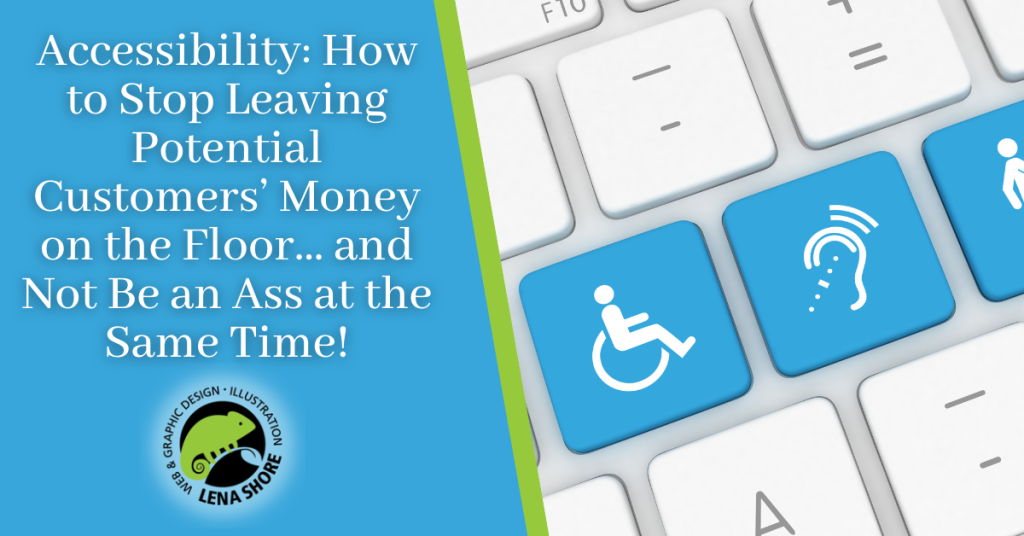Accessibility: How to Stop Leaving Potential Customers’ Money on the Floor… and Not Be an Ass at the Same Time!
Updated: November 27, 2023 • By Lena Shore
Filed under: Accessibility, Print Design, Web Design

What is Accessibility and Why Does it Matter to Your Business?
At root, Accessibility is about showing customers you care about them and extending a welcome mat to people want to spend money with you, but may not feel like their needs are adequately addressed enough to do so. I think everyone understands that your brick and mortar business needs to be wheelchair accessible, but what about your online presence? How do you add a ramp to a website?
What Does Accessibility Mean for Your Digital Content?
When I say “Digital Content”, I mean your websites, pdfs, graphs, videos, social media, and other online content. Don’t we want our documents and websites to be available to as many people as possible? You might think that it doesn’t matter because none of your clients are blind or deaf. But, if you’ll forgive the pun, you are being short-sighted.
There are many types of disabilities
Disabilities happen to everyone.
- Permanent: Vision or hearing loss
- Temporary: A broken arm or hearing loss due to an ear infection
- Situational: Difficulty hearing in a loud room or difficulty seeing a screen because of glare from the sun
- Episodic: Migraines, vertigo, chronic pain, vertigo, or mental illnesses like PTSD, or bipolar disorder.
Disabilities can affect people’s ability to consume content in a variety of ways. Here are a few examples.
- Color: Color blindness or low vision can greatly affect the ability to comprehend what you are looking at. For example, a chart that only uses colors to display information may not be useful to someone with color-based disabilities. (1 in 12 men are color blind — that’s 8%. 1 in 200 women are color blind — or 0.5%. You wouldn’t push eight and a half percent of your customers back out the front door of your business, would you?)
- Fonts: Certain fonts are more difficult to read than others for people with dyslexia. (5 to 15 percent of Americans—14.5 to 43.5 million children and adults—have dyslexia.)
- Proper formatting: Documents or websites that aren’t tagged properly can’t be read easily by screen readers. (According to government studies around 2.9% of people are using a screen reader)
- Videos: If you aren’t making use of closed captioning you are affecting people who are deaf, but also many people who prefer to read captions on videos for a variety of reasons. (It is estimated that 89% of Americans use closed captions for a wide variety of reasons.)
Why does making things accessibility matter?
If you care about the warm and fuzzies.
Making your documents and websites accessible is the right thing to do. We should be removing barriers so all people can experience our content. We all benefit.
I care about the dotted line, not warm and fuzzies.
Maybe you don’t care about humanity more than your wallet. You are in business to make money. Or maybe you work for someone that needs convincing. Let’s hit a few high points:
20-40% of your audience has some type of disability. That’s huge. Are you willing to let a minimum of 20% your audience be ignored? They could be a customer. (And more to the point, this market is not currently being properly capitalized on. They are waiting for you to step up first.)
Better SEO (Search Engine Optimization). All the things that are good for accessibility are also good for search engines (like google) that bring traffic to your website.
The Law. You could get sued. Numerous legal rulings have happened because a company’s digital content wasn’t accessible. (There were 4,000 cases in 2020 related to accessibility, and this number is only going to rise. Don’t be one of them.)
In the United States, accessibility falls under:
- Americans with Disabilities Act, or the ADA (civil rights law)
- Section 508 of the Rehabilitation Act of 1973 (applies to federal agencies)
- The U.S. Access Board oversees accessibility standards (that includes digital accessibility):
- WCAG: internationally recognized web standards
- PDF/UA: internationally recognized PDF standards
How do I make things accessible?
While manual checking is needed the ensure accessibility, you can run some automated checkers to get started. Here are some programs that have accessibility checkers:
- Microsoft Word
- Microsoft PowerPoint
- Adobe Acrobat Pro
Major items you are looking for:
- Alt text is text that screen readers read aloud when they come upon a photo, logo, icon, chart, or other graphic.
- Tags are how screen readers navigate a document. They should be in the proper order for readability.
- Reading Order is another way screen readers navigate a document.
- Artifacting means to hide unnecessary content from a screen reader. If it doesn’t need to be read aloud for the content to be understood, artifact it!
- Color Contrast should be checked to meet the WCAG color ratio requirements. There are several tools to check this, but my current favorites are the CCA (Colour Contrast Analyzer) and Experte’s Color Contrast Checker.
Accessibility is a journey, not a light switch. It can’t happen overnight, but with a little bit of knowledge and effort towards making your content consumable to everyone you can make a huge difference.
If you have any questions about accessibility as how it relates to your website or printed materials, please reach out.
This article is part of a series of monthly articles I will be posting on accessibility and how it relates to our websites and marketing materials. They will cover how it affects you, why you should care, pitfalls, and what you can do about it.